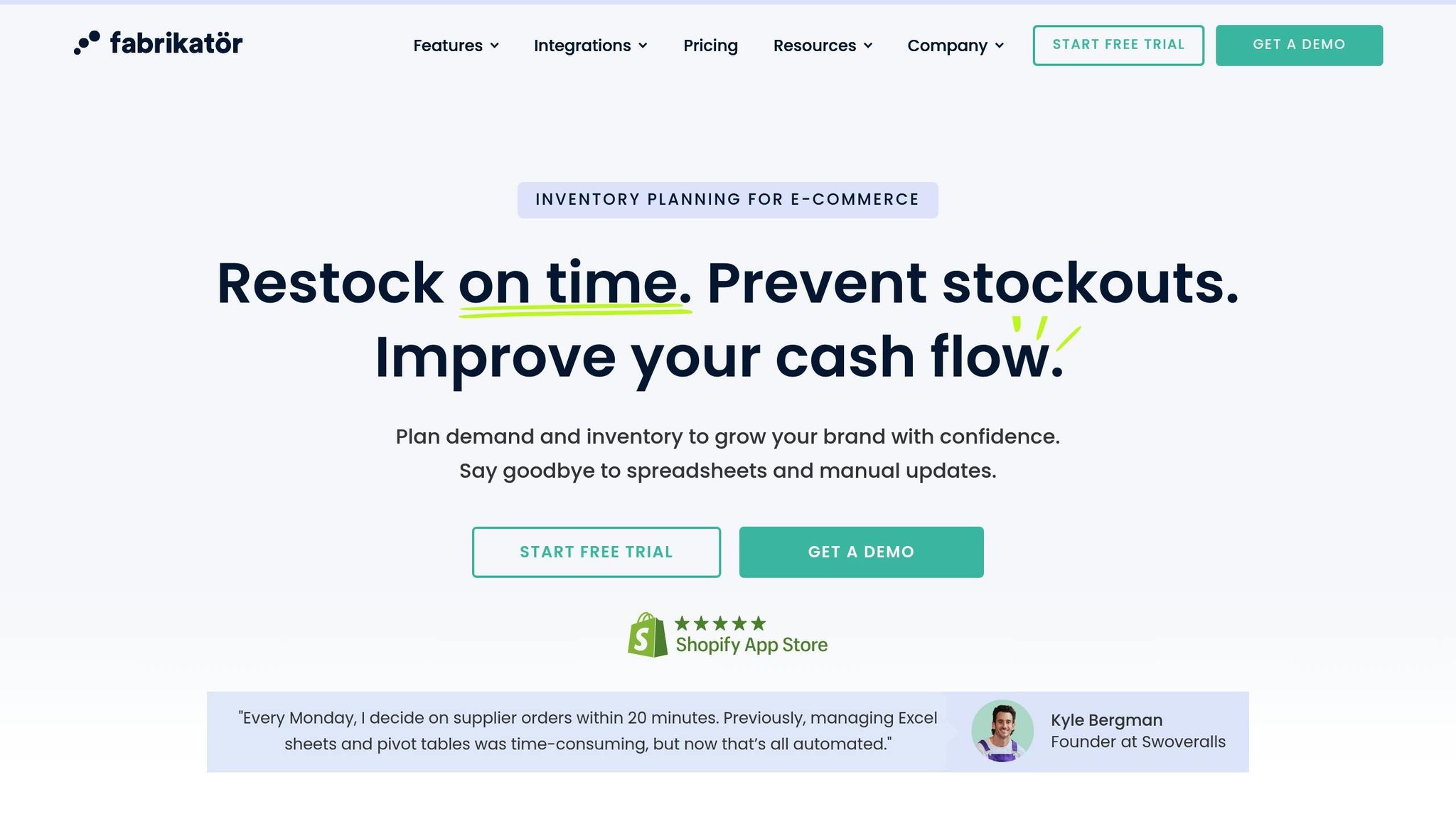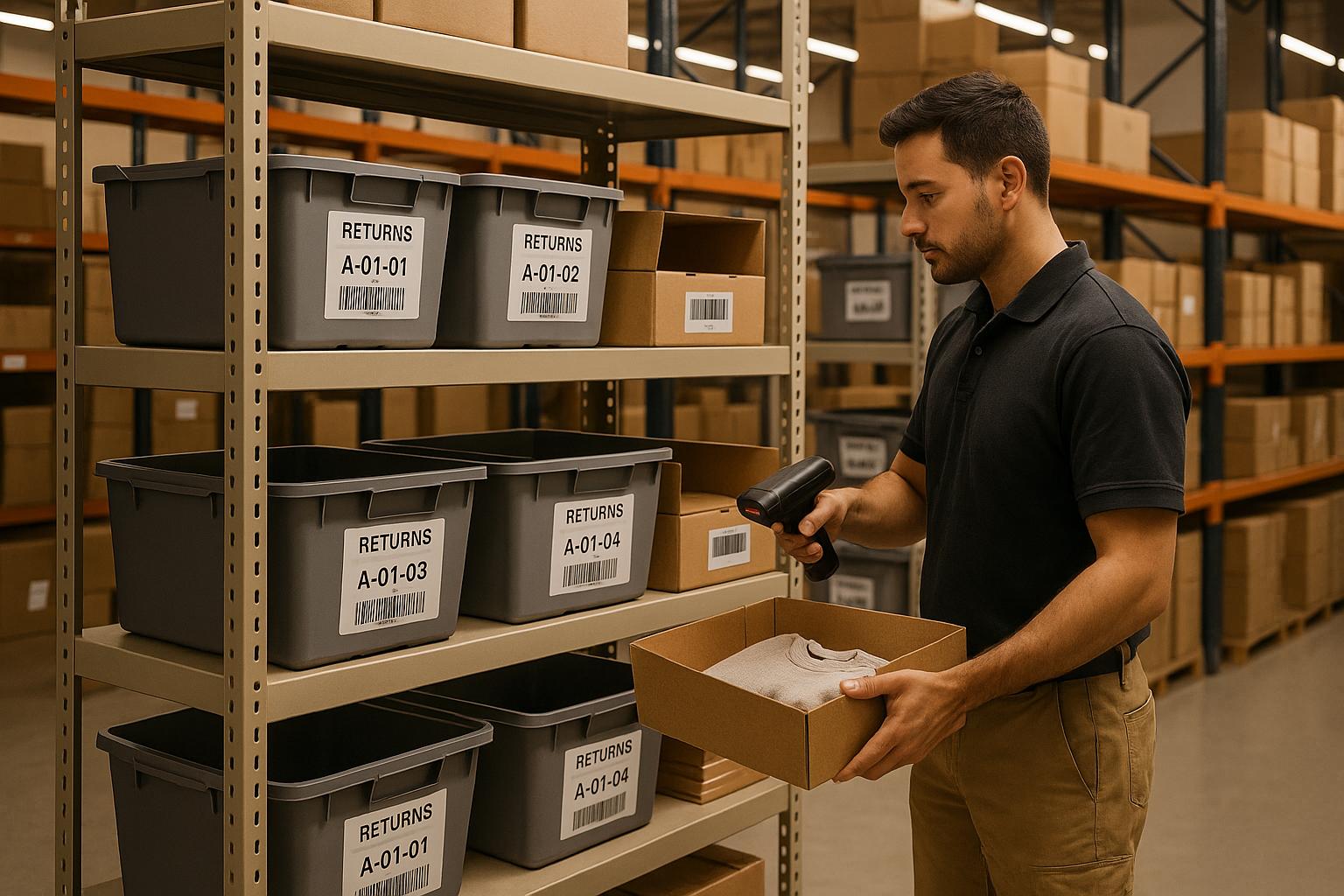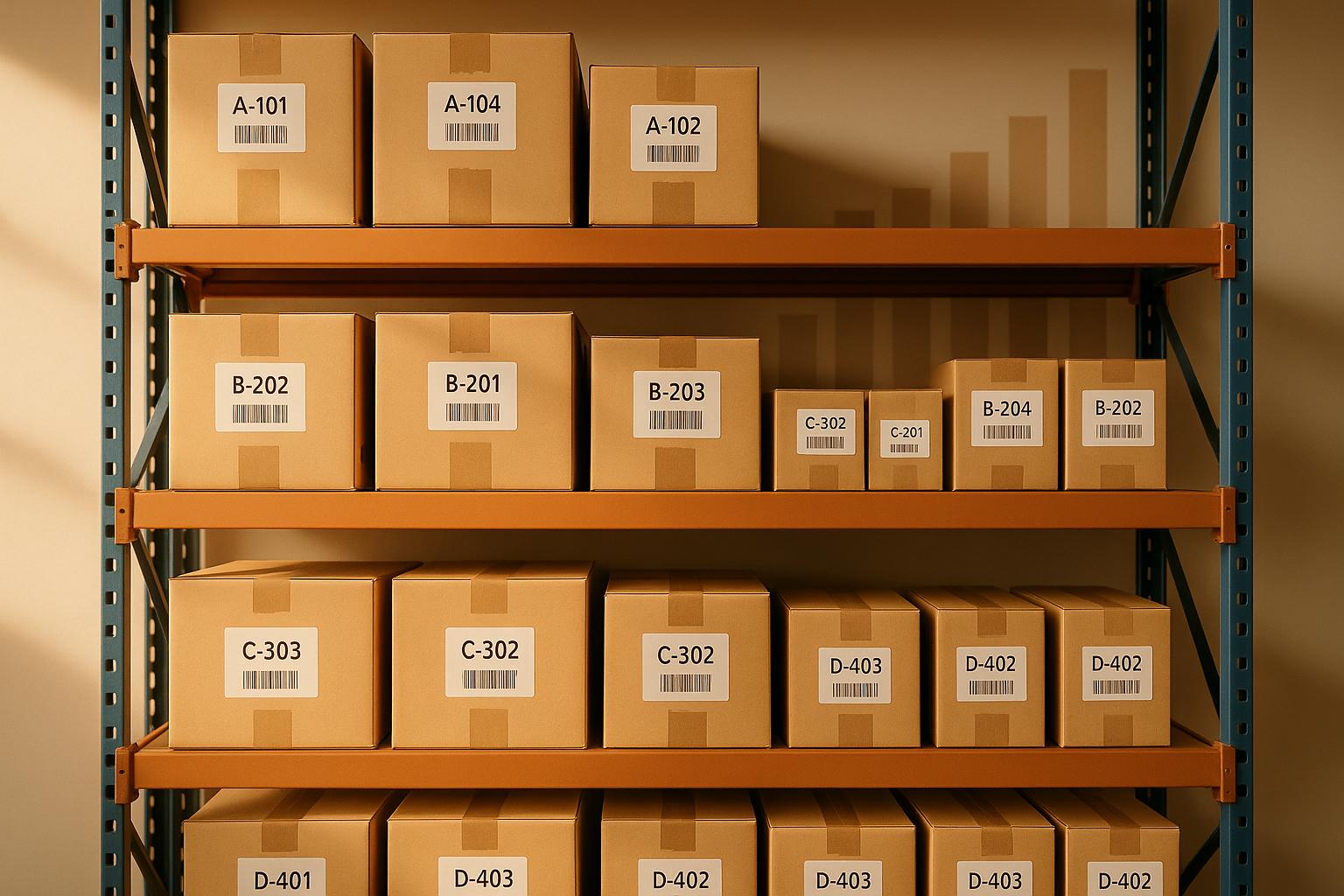Ultimate Guide to DTC Inventory Management

Managing inventory effectively is the backbone of any Direct-to-Consumer (DTC) brand. Here's why it matters:
- DTC sales will hit $186 billion in 2025. Poor inventory management can lead to stockouts, overstocking, and lost revenue.
- Key challenges include: managing inventory across multiple sales channels, real-time tracking, and meeting high customer expectations like 24-hour delivery.
- Solutions include: AI-powered demand forecasting, real-time inventory tracking, and leveraging third-party logistics (3PL) providers for scalability.
What you’ll learn:
- How to align inventory strategies with business goals.
- Practical tips for improving inventory turnover, tracking, and fulfillment.
- The role of technology and 3PL services in scaling operations.
Your inventory system isn’t just about keeping products in stock - it’s about driving growth, improving customer satisfaction, and ensuring long-term success.
Unlock DTC Inventory Management Secrets with Bahadir Efeoglu from Fabrikator | Ecommerce Business

Core Principles of Effective Inventory Management
Effective inventory management is the backbone of any successful direct-to-consumer (DTC) business. It directly impacts profitability and ensures customers remain satisfied. By sticking to a few essential practices, brands can grow their operations smoothly while avoiding costly inventory missteps.
Inventory Turnover Optimization
Inventory turnover shows how quickly a business sells and restocks its products during a specific time frame. A high turnover rate reflects strong sales and efficient inventory practices, whereas a low rate often points to sluggish stock movement that ties up valuable resources. Poor turnover management can cost retailers billions each year.
Some DTC brands have found clever ways to tackle this challenge. For instance, Tortuga, a company specializing in backpacks, clears out older inventory by selling it at discounted prices on Amazon while keeping premium pricing on their own website. Similarly, Three Ships, a skincare brand, boosted turnover by expanding to Target’s online marketplace, giving them access to a broader U.S. audience without disrupting their existing sales channels.
To improve turnover, focus on precise demand forecasting and regularly review performance. Identify slow-moving products and consider promotions, discounts, or bundles to encourage sales. Setting clear reorder points can also help prevent overstocking and ensure your capital is used wisely.
Once turnover is optimized, keeping track of inventory in real time becomes the next critical step.
Real-Time Inventory Tracking
Real-time tracking of inventory across all sales channels is crucial to avoid overselling or running out of stock. Keeping your website, social media platforms, marketplaces, and physical stores in sync ensures accuracy and reduces customer frustration.
One effective tool for this is RFID technology. RFID tags automatically update inventory counts, which helps eliminate errors and improves warehouse efficiency. Additionally, automatic reordering systems, triggered by live demand data, make supplier relationships and expedited delivery agreements even more effective.
Fulfillment Performance Metrics
Tracking the right metrics is essential for evaluating how well your inventory management meets customer expectations and supports smooth operations. DTC brands should monitor key fulfillment metrics like initial order fill rate, same-day shipping rates, error-free shipments, dock-to-stock time, and returns processing speed.
"You can't improve something you haven't measured." – Lord Kelvin
Here’s a comparison of fulfillment metrics across different companies:
-
Fulfillment Metrics
-
Initial Order Fill Rate
- Company A: 92%
- Company B: 89%
- Company C: Not Measured
- Company D: 60%
- Company E: 67%
- Company F: 82%
-
Orders Shipped Same Day
- Company A: 91%
- Company B: 92%
- Company C: Not Measured
- Company D: 20%
- Company E: 67%
- Company F: 60%
-
Orders Shipped Error-Free
- Company A: 99.2%
- Company B: 97%
- Company C: 99.6%
- Company D: 99.9%
- Company E: 95%
- Company F: 100%
-
Dock-to-Stock Time
- Company A: Same shift
- Company B: Same shift
- Company C: Not Measured
- Company D: 2 days
- Company E: Next day
- Company F: Next day
-
Returns Processing
- Company A: 3 hours
- Company B: 5 hours
- Company C: 4 days
- Company D: 2 hours
- Company E: 2 hours
- Company F: 2 hours
-
Initial Order Fill Rate
For example, Company A’s 92% fill rate significantly outperforms Company D’s 60%, largely due to differences in product strategies. Errors in order fulfillment can cost between $35 and $50 per mistake.
A real-world example comes from RTJ Industries, which initially achieved a 93.11% perfect order fulfillment rate, based on 95% on-time deliveries, 99% accuracy, and 99% complete orders. However, after a month, their rate dropped to 92.2% as these metrics fell slightly, prompting immediate corrective actions.
Technologies like barcode scanning and voice picking can help brands achieve near-perfect fulfillment rates of 99% or higher. Aiming for dock-to-stock times of two hours or less and processing returns within 8–12 hours are also key benchmarks. The concept of "perfect order fulfillment" combines multiple metrics. For example, if on-time delivery is 96%, accuracy is 98%, and complete order capture is 98%, the overall perfect order score would be about 92.2%. Even small gains in individual metrics can lead to noticeable improvements in the overall score.
Strategies for DTC Inventory Management
Direct-to-consumer (DTC) brands face unique challenges when it comes to inventory management. To navigate these complexities, brands need clear, actionable strategies that ensure smooth operations and minimize costly mistakes.
Demand Forecasting Methods
Accurate demand forecasting is the backbone of successful inventory management. Traditional methods relying solely on historical data often fall short in today’s fast-changing market. Enter AI-powered forecasting. According to a Gartner survey, 45% of companies now use machine learning for demand forecasting, and McKinsey Digital highlights its impact: AI-enhanced forecasting can cut supply chain errors by 30–50% while reducing lost sales due to stockouts by up to 65%. On a broader scale, AI in manufacturing and supply chain planning could add between $1.2 trillion and $2 trillion in value.
Machine learning algorithms excel at analyzing diverse datasets and refining predictions over time. To get started with effective demand forecasting:
- Gather clean, comprehensive data from multiple sources, such as online sales, in-store transactions, and social media trends.
- Use advanced algorithms like neural networks or linear regression to process large datasets and uncover complex patterns.
- Customize forecasting models for specific product categories and regularly update them to adapt to market shifts.
Here’s how AI stacks up against manual forecasting:
-
Aspect
-
Manual Forecasting
- Processing Speed: Slow
- Data Analysis: Limited to historical data
- Accuracy: Lower
- Pattern Detection: Obvious trends only
- Real-time Updates: Requires manual updates
-
AI Forecasting
- Processing Speed: Fast
- Data Analysis: Handles diverse datasets
- Accuracy: Higher
- Pattern Detection: Detects hidden patterns
- Real-time Updates: Automatic with new data
-
Manual Forecasting
By leveraging AI, DTC brands can refine their inventory planning and avoid costly errors.
Stock Control Best Practices
Stock control is another critical piece of the puzzle. Poor inventory management costs U.S. and Canadian retailers around $350 billion annually due to stockouts and overstocks. Smart practices can help prevent these losses.
One effective method is ABC analysis, which categorizes inventory into three groups:
- A items: High-value products requiring frequent monitoring.
- B items: Medium-value products needing moderate attention.
- C items: Low-value products managed in bulk.
This system allows brands to focus resources on the top 20% of products that drive 80% of revenue.
Setting par levels - the minimum stock needed to meet demand - is another key practice. By analyzing past sales and regularly checking par levels, brands can determine when to adjust orders. Additionally, Just-In-Time (JIT) stocking minimizes excess inventory by ordering only what’s immediately needed.
Technology plays a vital role too. Tools like barcoding, RFID, and cloud-based inventory management software provide real-time updates. Use Economic Order Quantity (EOQ) calculations to balance order size and frequency, maintain safety stock for unexpected demand, and conduct regular audits through cycle counting or physical checks.
Backup Planning for Supply Disruptions
Supply chain disruptions can wreak havoc on DTC operations, making backup planning essential. Proactive measures can protect your brand from unexpected challenges.
Start with supplier diversification. Relying on a single supplier is risky, so build relationships with vendors across different regions to mitigate potential closures or regulatory changes. Brady Maller, EVP of strategy and sales at POLYWOOD, emphasizes:
"Making contingency plans for your supply chain to source from different regions as new regulations or closures occur are an essential part of any backup plan".
Strengthen these relationships with flexible contracts and clear contingency plans. Regularly monitor supplier performance and provide feedback to ensure reliability.
Technology can also provide a safety net. Tools like 5G, IoT, AI, and even 3D printing can keep supply chains moving when traditional methods falter. Supply chain monitoring systems, predictive analytics, and automated alerts can flag potential issues before they escalate.
Take a page from TaylorMade’s playbook. When demand for golf equipment surged in summer 2020, the company was ready. Dave Brownie, TaylorMade's Senior Vice President of Global Operations, explained:
"Having more robust systems helped us flow our inventory. After golf reopened, we were immediately shipping record demand with much less inventory".
To fully prepare, adopt the PPRR model - prevention, preparedness, response, and recovery. Map your supply chain to identify all suppliers and assess risks like financial instability or cybersecurity vulnerabilities. Regular vendor audits and due diligence can help address these risks.
Finally, invest in backup inventory for critical products, especially those with long lead times or single-source suppliers. Predictive supply chain analytics can simulate potential disruptions, while regular drills help refine contingency plans.
The payoff? AI-enhanced planning can lower transportation and warehousing costs by 5–10% and reduce supply chain administration expenses by 25–40%. These strategies ensure your DTC brand stays operational, even when the unexpected strikes.
sbb-itb-eafa320
Technology and Automation in Inventory Management
The rise of modern technology has transformed Direct-to-Consumer (DTC) inventory management, simplifying manual tasks and enabling smarter, data-driven decisions. These advancements pave the way for integrated systems that improve inventory accuracy and operational efficiency.
Inventory Management Systems and ERP Integration
Bringing together Inventory Management Systems (IMS) and Enterprise Resource Planning (ERP) software creates a unified platform for inventory, accounting, and customer relationship management (CRM). This integration offers real-time stock visibility and automates processes like order management, helping businesses avoid stockouts and overstocking.
ERP systems take automation to the next level by streamlining order processing, packing, and shipping. This leads to faster fulfillment times and fewer errors. They also simplify compliance by automatically capturing and storing essential data for reporting.
However, implementing ERP systems isn’t without challenges. According to Gartner, 75% of ERP projects fail. Success requires evaluating your current system, identifying gaps, and prioritizing integrations based on business needs. Industry-specific middleware and experienced partners can help ensure a smoother process.
"The real efficiency unlock comes when your ERP doesn't just store information, but becomes a connected hub for your entire order flow using an OMS built to enhance your current workflows."
AI and Machine Learning for Optimization
Artificial intelligence (AI) and machine learning are revolutionizing inventory management. Real-time systems use historical and current data to alert teams about low stock levels proactively. Automated Warehouse Management Systems (WMS) reduce human error in inventory calculations, improving accuracy and efficiency.
These technologies also enhance supply chain operations by providing real-time data to calculate key metrics like average inventory, turnover ratios, and lead times. For customers, this means better transparency about product availability, which is crucial as nearly 46% of businesses now prioritize customer experience over pricing and product.
Mark Riskowitz, VP of operations at Caraway, highlights the benefits of leveraging such tools:
"Cogsy allows us to have an exact understanding and visualization of what is going on in terms of product availability... Leveraging that information helps [our] team with data-driven internal and external planning to capitalize on all opportunities."
Additionally, AI-driven predictive capabilities support multichannel synchronization, a vital element in building a resilient DTC fulfillment strategy.
Multichannel Inventory Visibility
Managing inventory across multiple sales channels is essential as brands grow. Multichannel tools keep orders synchronized in real time, ensuring accurate stock levels and preventing overselling. These tools also speed up replenishment and improve operational agility by centralizing order management.
Cloud-based solutions are gaining traction, with 70% of multichannel e-commerce sellers using cloud-based listing software and 37% adopting automated inventory management tools. Real-time inventory tracking software provides insights for replenishing stock and planning promotions, making operations more agile and responsive.
Advanced analytics play a key role in forecasting demand and maintaining optimal stock levels, helping businesses adapt to market changes. Brands with strong omnichannel strategies see significant benefits - retaining 89% of their customers on average, compared to just 33% for those with weaker strategies.
For DTC brands working with third-party logistics (3PL) providers like JIT Transportation, these integrated tools enable real-time forecasting and centralized control across multiple locations. This unified approach strengthens the supply chain and enhances operational resilience.
Using 3PL Services for Scalable Inventory Management
As direct-to-consumer (DTC) brands expand, managing inventory in-house can quickly become a logistical headache. That’s where third-party logistics (3PL) providers step in, transforming inventory management into a strategic advantage. With DTC e-commerce sales forecasted to hit $186.6 billion by 2025, collaborating with a skilled 3PL isn’t just smart - it’s essential for staying competitive. In fact, implementing an effective DTC fulfillment strategy can increase revenue by over 25%. Let’s dive into how tailored 3PL solutions can help brands scale their operations while staying agile.
Custom 3PL Solutions for DTC Brands
Today’s DTC brands need more than just a warehouse - they need tailored services that align with their specific needs. JIT Transportation offers a suite of custom logistics solutions that go far beyond basic storage and shipping. For instance, their pick & pack services ensure that individual orders are processed accurately and shipped on time. If your brand sells product bundles or seasonal collections, their kitting and assembly services can pre-package items to streamline fulfillment and improve presentation.
For brands offering high-end or delicate products, white glove handling ensures these items are treated with care throughout the entire process. Tech-focused DTC brands also benefit from JIT’s testing and revision services, which allow for quality checks or updates before shipping. To maintain optimal inventory levels, their Vendor Managed Inventory (VMI) system leverages data-driven insights, ensuring stock is always where it’s needed.
Integration is another game-changer. JIT connects seamlessly with major e-commerce platforms, automating fulfillment processes and providing real-time tracking. This eliminates manual errors, reduces inventory discrepancies, and simplifies operations. For brands selling across multiple channels - whether online, wholesale, or retail - JIT’s unified approach ensures consistent inventory management and reporting.
As Armando Otiz, Manager 3PL/Inventory, puts it:
"In logistics, consistency is everything - and that's exactly what JIT delivers. Their transportation services are dependable, seamless, and backed by a team that truly understands our business needs. Working with JIT has made a tangible difference in our efficiency and customer satisfaction."
Next, we’ll explore how JIT’s nationwide network and cutting-edge technology amplify these benefits.
Nationwide Network and Advanced Technology
In today’s fast-paced e-commerce world, geographic reach is a must. A well-established network allows brands to deliver quickly and consistently. With the right logistics setup, you can reach 95% of U.S. households within two days using ground shipping. JIT Transportation makes this possible with 14 strategically located warehouses across the country, covering over 1 million square feet of space. Their carrier network includes more than 500 carriers and 200 trucks, giving them the capacity to handle a wide range of shipments.
Behind this network is a robust technology infrastructure. JIT’s Warehouse Management System (WMS) and transportation tracking tools provide real-time visibility into inventory and shipments. Custom reporting and analytics help brands monitor performance and identify areas for improvement. This technology ensures that inventory remains organized and prevents the fragmentation that often challenges growing DTC businesses.
Building Supply Chain Resilience
As customer demands for faster shipping grow, supply chain resilience becomes a critical advantage. Consider this: 54% of online shoppers abandon their carts if shipping takes too long. Reliable fulfillment directly impacts your bottom line. JIT’s cross-docking solutions speed up shipments by reducing storage time, while their returns management (RMA) services streamline reverse logistics. They also offer pooling distribution and consolidation services to lower shipping costs by coordinating regional deliveries.
Value-added services like product localization, quality inspections, and custom packaging allow brands to maintain their unique identity, even when outsourcing fulfillment. And with over 30 years of experience, JIT Transportation has built a reputation for reliability. Their proactive communication - complete with regular updates and live tracking - helps brands respond quickly to potential disruptions. If unexpected issues arise, their expedited transportation services ensure delivery commitments are met without breaking the bank.
For growing DTC brands, partnering with a 3PL offers access to enterprise-level logistics without the hefty investment of building infrastructure in-house. This partnership not only accelerates growth but also minimizes the risks tied to scaling operations. By handling the complexities of logistics, 3PL providers like JIT Transportation allow brands to focus on what they do best: creating great products and delivering exceptional customer experiences.
Conclusion: Key Takeaways for DTC Inventory Success
Managing inventory for direct-to-consumer (DTC) brands isn't just about keeping shelves stocked - it’s about laying the groundwork for long-term growth. In a market where competition continues to heat up, brands that fine-tune their inventory strategies are better equipped to grab a larger share of the market.
Aligning inventory with your business goals is a growth driver. Whether you're scaling quickly, navigating seasonal demand, or aiming to deliver top-tier customer experiences, your inventory approach needs to match those objectives. This goes beyond simply tracking stock; it’s about using tools like real-time updates, demand forecasting, and performance data to make smarter decisions.
Technology plays a key role in turning inventory into a competitive advantage. Advanced inventory systems, ERP integrations, and AI tools provide the automation and visibility necessary to scale operations efficiently while cutting down on manual errors.
On top of automation and data-driven strategies, partnering with third-party logistics (3PL) providers can add flexibility and scalability. Over the past year, nearly all businesses have faced supply chain disruptions. About half of them reported that these issues caused significant planning difficulties. Even minor disruptions can lead to major financial losses, making supply chain resilience a critical factor for success.
A strong 3PL partner offers more than just storage and shipping - they provide solutions that reduce capital investment while delivering enterprise-level capabilities. For example, JIT Transportation offers services like pick and pack, kitting, white-glove handling, and vendor-managed inventory, all supported by a nationwide network that ensures broad reach and adaptability.
"JIT has been a trusted logistics partner for Seagate for years, and their reliability is unmatched. Day in and day out, they prove their commitment to seamless operations, ensuring our supply chain stays on track. We know we can count on JIT to deliver, every time."
The numbers back it up. ECR4Kids saved nearly $700,000 annually by outsourcing fulfillment to a 3PL. LS2 Helmets improved delivery speeds by 60%, reaching 70% of U.S. customers within two days. Meanwhile, O2 managed to grow its business fivefold while achieving 98% on-time fulfillment during the challenges of COVID-19.
For DTC brands looking to scale, the roadmap is clear: invest in the right technology, build a resilient supply chain, and collaborate with logistics partners who understand your specific needs. Brands that master these elements won’t just weather disruptions - they’ll transform them into opportunities for growth.
Your inventory strategy today shapes your market position tomorrow.
FAQs
How does AI-driven demand forecasting help DTC brands manage inventory more effectively?
AI-powered demand forecasting enables DTC brands to fine-tune their inventory management by examining historical sales patterns, seasonal fluctuations, and external influences. This approach helps accurately anticipate customer demand, reducing problems like overstocking or running out of stock. The result? Improved stock control and smarter cost management.
With AI in the mix, brands can also coordinate their strategies across various sales channels and markets. It allows them to swiftly respond to changes in demand or unforeseen supply chain hiccups. This not only ensures a smoother experience for customers but also makes business operations more flexible and efficient.
What are the advantages of connecting your Inventory Management System (IMS) with ERP software for DTC brands?
Integrating your Inventory Management System (IMS) with ERP software can make a big difference in how smoothly your DTC business runs. This integration allows real-time data to flow seamlessly across your operations, giving you a clear view of inventory levels, order statuses, and stock movements. It also helps cut down on errors from manual data entry and reduces the chances of overstocking or running out of stock.
By simplifying supply chain processes, this connection leads to more accurate forecasting, smarter decisions, and lower costs. On top of that, it boosts reporting capabilities, helping you stay flexible and efficient in managing inventory while meeting customer demands with ease.
How can 3PL providers help DTC brands grow and manage their operations effectively?
Third-party logistics (3PL) providers are a game-changer for DTC brands looking to expand. They take care of essential tasks like warehousing, order fulfillment, and shipping, freeing up brands to concentrate on what they do best - building their business.
With the help of cutting-edge technology, nationwide networks, and efficient workflows, 3PL providers make it possible for brands to meet customer expectations faster and more affordably. They offer features like real-time inventory tracking, smooth integration with e-commerce platforms, and dependable delivery services. All of this not only boosts operational efficiency but also improves the overall customer experience.
Teaming up with a reliable 3PL provider allows DTC brands to grow without sinking large amounts of money into infrastructure. This flexibility makes it easier to handle market growth or seasonal spikes without breaking a sweat.
Related posts
Related Articles

Top 3PL KPIs for Scaling E-commerce Brands

Best Practices for Returns Reconciliation in 3PL

